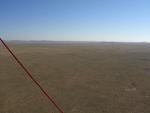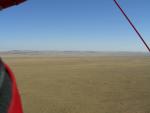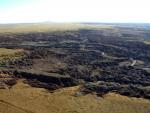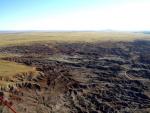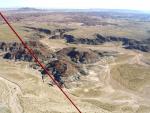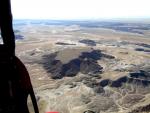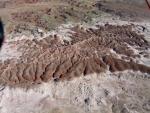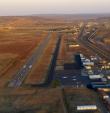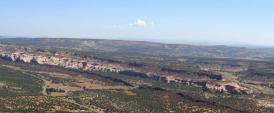|
|
Thursday June 01, 2006Michael and I took off from Winslow, and headed to Gallup (GUP). Michael, due to fuel constraints, landed at Holbrook (P14) and Rusty picked him up. I stayed in the air and continued on. The direct line distance to Gallup is 114 miles, though with wiggle waggle its a bit more. The first part of the trip there was a decent tail wind, and I thought the whole flight might be over in about 3 ½ hours. But at 8am sharp it was as if someone threw a switch, and the thermals kicked in. The tailwind disappeared, and turned into a headwind. The terrain changed as well. It evolved from flat to small canyons and badlands. The closer I got to Gallup, the rougher the terrain. Combined with the thermals and wind, the ride was pretty rough. Now was the time when Id find out how fuel efficient the HKS really is. I knew that theoretically I could fly for at least 5 hours, and have an hour reserve. But that was assuming I was at a straight and level throttle setting most of the time. On this flight I was full throttle most of the time, trying to control things. On the up side I was flying at about 7,500 msl, with an actual density altitude of over 10,000 feet. So I had the fuel mixture leaned out a fair amount. Id already been in the air for almost 3 hours. The GPS ete readout (estimated time enroute) varied wildly, from 4 hours (when I hit a strong headwind) to 1 1/2 hours (when I was blessed with a strong tailwind). Absolutely no consistency, with conditions changing every few seconds. Some of the thermals were doozies. At one point I was flying toward a ridge and hit a very strong downdraft. If the rate of decent didn't change, I wasn't going to clear the ridge. It did slow just a bit, and I cleared the ridge by 300 feet. On the other side I gratefully caught the updraft (of about 700 fpm) and rode it for all it was worth. Ended up topping out at about 8,400 msl. Voyager chugged on. When the flight timer hit 4 hours the GPS ete read 2 hours. Gallup was only 20 miles away. So close, yet…. I decided to go the full 5 hours and then land on a service road if I hadn't reached Gallup . The wind Gods decided to smile upon me, and suddenly I was zipping along at 40 mph. I covered the last 20 miles in 30 minutes. Let me tell you, the sight of the Gallup airstrip, when it came into view, was quite a relief. (It was hidden by a ridge until I was only 7 miles away.) I was up at 8,400 msl, about 2,000 feet above Gallup , and had to fight the thermals to descend. The Gallup ATIS reported 8 knot winds that were 50 degrees crosswind. Not good news, as the airport layout doesn't leave a lot of options for landing other than in the orientation of the runway. I crabbed in, fighting mini-thermals, and finally reunited with Terra Firma on the taxiway parallel to the runway. Was it pretty? Probably not. I wasn't too concerned about how graceful it looked. I wanted to get back on the ground. After landing I taxied onto the turnoff and dropped the chute. The flight timer read 4 ½ hours. I sat there and rested a minute or two. A man walked up and related how surprised he was to see anyone flying such a light craft later than 8am. The time was now 10:15. I climbed out of Voyager, and anxiously looked at the lower tank. To my amazement there were still 3 gallons left. Folks, if this doesn't make you an HKS believer, nothing will. Before the trip started I heard a chorus of people tell me they didn't think this engine has the umph to do the job. It does. I flew in density altitude of over 11,000 feet today. The manual says not to run the RPM higher than 5,800 for more than 3 minutes at a time. Ive been running it at 6,200 for, well, I'm not even sure how long. For as long as necessary I guess. I'm not telling you to disregard the manual and beat the **** out of the engine. I'm flying in extreme conditions. But this engine is handling all I can dish out, on a machine weighing 480 pounds dry, plus my weight, plus 18 gallons of fuel. It hasn't missed a beat. And when it comes to fuel economy, I think this flight says it all. I was full-out most of the time, and still consumed only 3.33 gallons per hour. Ive had some flights where fuel consumption was only 2.8 gallons per hour. And I have to give credit to the PD 550 as well. Ever since I switched to the larger chute the Voyager climbs better, needs less throttle, and flies faster. The rest of the day was rather uneventful. Replaced a fuse, and spoke to the local CAP (Civil Air Patrol) group. Turns out this CAP is the most decorated in the country. The wind tomorrow morning will probably keep us in Gallup . From here were headed to Grants (GNT). We have to fly through a pass which will make this leg, though only 60 miles in length, one of the most dangerous of the trip.  |
